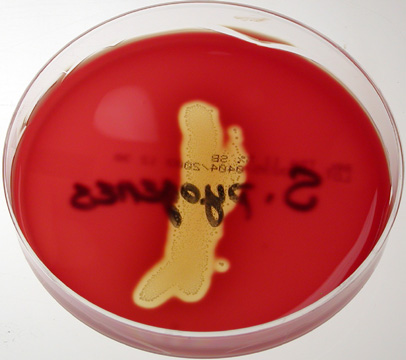Blood Agar
Blood agar contains general nutrients and 5% sheep blood. It is useful for cultivating fastidious organisms and for determining the hemolytic capabilities of an organism.
Some bacteria produce exoenzymes that lyse red blood cells and degrade hemoglobin; these are called hemolysins. Bacteria can produce different types of hemolysins. Beta-hemolysin breaks down the red blood cells and hemoglobin completely. This leaves a clear zone around the bacterial growth. Such results are referred to as β-hemolysis (beta hemolysis). Alpha-hemolysin partially breaks down the red blood cells and leaves a greenish color behind. This is referred to as α-hemolysis (alpha hemolysis). The greenish color is caused by the presence of biliverdin, which is a by-product of the breakdown of hemoglobin. If the organism does not produce hemolysins and does not break down the blood cells, no clearing will occur. This is called γ-hemolysis (gamma hemolysis).
The hemolysins produced by streptococci perform better in an anaerobic environment. Because of this, it is standard procedure to streak a blood plate and then stab the loop into the agar to provide an area of lower oxygen concentration where the streptolysins can more effectively break down the blood cells.
 |
This streptococcus pyogenes exhibits β-hemolysis. |
